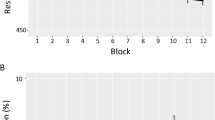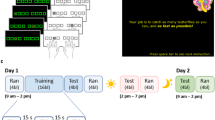Abstract
Little is known about how children acquire new motor sequences. In particular, it is not clear if the same learning progression observed in adults is also present in childhood nor whether motor skills are acquired in a similar fashion across development. In the present study we used the multi-finger sequencing task (MFST), a variant of the serial reaction time (SRT) task, to study motor sequence learning, across two consecutive days, in three cross-sectional samples of children aged 6, 8, and 10 years, and a control sample of adults. In the MFST, participants reproduced 10-element sequences of key presses on an electronic keyboard, using four fingers of the right hand. Each block of practice included 10 intermixed trials of a Repeated (REP) sequence and four trials of Random (RAN) sequences. Performance was assessed by examining changes in accuracy, a component of the task that requires the association of the visual stimulus with the motor response, and response synchronization, a component that requires fine-grained sensorimotor integration and timing. Additionally, participants completed Recognition and Recall tests, to assess explicit knowledge of the repeated sequence. Overall, results showed a developmental progression in motor sequence learning within and across days of practice. Interestingly, the two behavioral measures showed different developmental trajectories. For accuracy, differences were greatest for the two youngest groups early in learning, and these groups also showed the greatest rate of improvement. However, by the end of Day 2, only the 6-year-olds still lagged behind all other groups. For response synchronization, all child groups differed from adults early in learning, but both child and adult groups showed similar rates of improvement across blocks of practice. By the end of Day 2, 10-year-olds reached adult levels of performance, whereas 6- and 8-year-olds did not. Taken together, the dissociation observed with our two behavioral measures of sequence learning is consistent with the hypothesis that accuracy or finger-stimulus association may rely on cortical pathways that show the greatest maturation between ages 6 and 10; whereas motor timing and sensorimotor integration may rely on subcortical pathways that continue to develop into young adulthood. Despite developmental differences across blocks of practice on both behavioral measures, there were no significant group differences for either the Recognition or Recall tests. We suggest that explicit knowledge of the MFST is not directly linked to task performance, thus challenging the implicit–explicit distinction in pediatric SRT studies assessing the developmental invariance model.






Similar content being viewed by others
References
Badan M, Hauert C-A, Mounoud P (2000) Sequential pointing in children and adults. J Exp Child Psychol 75:43–69
Barnea-Goraly N, Menon V, Eckert M, Tamm L, Bammer R, Karchemskiy DantC, Reiss A (2005) White matter development during childhood and adolescence: a cross-sectional diffusion tensor imaging study. Cereb Cortex 15:1848–1854
Contreras-Vidal J, Bo J, Boudreau J, Clark J (2005) Development of visuomotor representations for hand movement in young children. Exp Brain Res 162:155–164
De Guise E, Lassonde M (2001) Callosal contributions to procedural learning in children. Dev Neuropsychol 19:253–272
Denckla M (1973) Development of speed in repetitive and successive finger-movements in normal children. Dev Med Child Neurol 15:635–645
Dorfberger S, Adi-Japha E, Karni A (2007) Reduced susceptibility to interference in the consolidation of motor memory before adolescence. PLoS ONE 2:e240
Doyon J, Benali H (2005) Reorganization and plasticity in the adult human brain during learning of motor skills. Curr Opin Neurobiol 15:161–167
Ferrel C, Bard C, Fleury M (2001) Coordination in childhood: modifications of visuomotor representations in 6- to 11-year-old children. Exp Brain Res 138:313–321
Fischer S, Hallschmid M, Elsner AL, Born J (2002) Sleep forms memory for finger skills. Proc Natl Acad Sci USA 99:11987–11991
Fischer S, Wilhelm I, Born J (2007) Developmental differences in sleep's role for implicit offline learning: comparing children with adults. J Cogn Neurosci 19:214–227
Garvey M, Ziemann U, Bartko J, Denckla M, Barker C, Wassermann E (2003) Cortical correlates of neuromotor development in healthy children. Clin Neurophysiol 114:1662–1670
Gogtay N, Giedd J, Lusk L, Hayashi K, Greenstein D, Vaituzis A, Nugent T, Merman D, Clasen L, Toga A, Rapoport J, Thompson P (2004) Dynamic mapping of human cortical development during childhood and through early adulthood. Proc Natl Acad Sci USA 101:8174–8179
Hager-Ross C, Schieber M (2000) Quantifying the independence of human finger movements: comparisons of digits, hands and movement frequencies. J Neurosci 20:8542–8550
Hikosaka O, Nakahara H, Rand M, Sakai K, Lu X, Nakamura K, Miyauchi S, Doya K (1999) Parallel neural networks for learning sequential procedures. Trends Neurosci 22:464–471
Hikosaka O, Nakamura H, Sakai K, Nakahara H (2002) Central mechanisms of motor skill learning. Curr Opin Neurobiol 12:217–222
Johnson J, Newport E (1989) Critical period effects in second language learning: the influence of maturational state on the acquisition of English as a second language. Cogn Psychol 21:60–99
Karni A, Meyer G, Rey-Hipolito C, Jezzard P, Adams M, Tuner R, Ungerleider L (1998) The acquisition of skilled motor performance: fast and slow experience-driven changes in primary motor cortex. Proc Natl Acad Sci USA 95:861–868
Knudsen E (2004) Sensitive periods in the development of the brain and behavior. J Cogn Neurosci 16:1412–1425
Kooistra L, Crawford S, Dewey D, Cantell M, Kaplan B (2005) Motor correlates of ADHD: contribution of reading disability and oppositional defiant disorder. J Learn Disabil 38:195–206
Korman M, Raz N, Flash T, Karni A (2003) Multiple shifts in the representation of a motor sequence during the acquisition of skilled performance. Proc Natl Acad Sci USA 100:12492–12497
Krakauer J, Shadmehr R (2006) Consolidation of motor memory. Trends Neurosci 29:58–64
Kuhtz-Buschbeck J, Stolze H, Johnk K, Boczek-Funcke A, Illert M (1998) Development of prehension movements in children: a kinematic study. Exp Brain Res 122:424–432
Lang C, Schieber M (2004) Human finger independence: limitations due to passive mechanical coupling versus active neuromuscular control. J Neurophysiol 92:2802–2810
Mackie S, Shaw P, Lenroot R, Pierson R, Greenstein D, Nugent T, Sharp W, Giedd J, Rapoport J (2007) Cerebellar development and clinical outcome in attention deficit hyperactivity disorder. Am J Psychiatry 164:647–655
Meulemans T, Van der Linden M, Perruchet P (1998) Implicit sequence learning in children. J Exp Child Psychol 69:199–221
Nissen M, Bullemer P (1987) Attentional requirements of learning: evidence from performance measures. Cogn Psychol 19:1–32
O’Driscoll G, Depatie L, Holahan A, Savion-Lemieux T, Barr R, Jolicoeur C, Douglas V (2005) Executive functions and methylphenidate response in subtypes of attention-deficit/hyperactivity disorder. Biol Psychiatry 57:1452–1460
Oldfield R (1971) The assessment and analysis of handedness: the Edinburgh inventory. Neuropsychologia 9:97–113
Paus T, Zijdenbos A, Worsley K, Collins D (1999) Structural maturation of neural pathways in children and adolescents: in vivo study. Science 283:1908–1911
Paus T, Collins D, Evans A, Leonard G, Pike B, Zijdenbos A (2001) Maturation of white matter in the human brain: a review of magnetic resonance studies. Brain Res Bull 54:255–266
Pitcher T, Piek J, Hay D (2003) Fine and gross motor ability in males with ADHD. Dev Med Child Neurol 45:525–535
Reber A (1993) Implicit learning and tacit knowledge: an essay on the cognitive unconscious. Oxford University Press, New York
Reilly K, Hammond G (2000) Independence of force production by digits of the human hand. Neurosci Lett 290:53–56
Reilly K, Hammond G (2006) Intrinsic hand muscles and digit independence on the preferred and non-preferred hands of humans. Exp Brain Res 173:564–571
Robertson E, Pascual-Leone A, Miall R (2004) Current concepts in procedural consolidation. Nat Rev Neurosci 5:1–6
Savion-Lemieux T, Penhune V (2005) The effects of practice and delay on motor skill learning and retention. Exp Brain Res 161:423–431
Schlaug G (2001) The brain of musicians. A model for functional and structural adaptation. Ann N Y Acad Sci 930:281–299
Seger C (1997) Two forms of sequential implicit learning. Conscious Cogn 6:108–131
Slobounov S, Chiang H, Johnston J, Ray W (2002) Modulated cortical control of individual fingers in experienced musicians: an EEG study. Clin Neurophysiol 113:2013–2024
Smits-Engelsman B, Sugden D, Duysens J (2006) Developmental trends in speed accuracy trade-off in 6 to 10-year-old children performing rapid reciprocal and discrete aiming movements. Hum Mov Sci 25:37–49
Sowell E, Thompson P, Holmes C, Jernigan T, Toga A (1999) In vivo evidence for post-adolescent brain maturation in frontal and striatal regions. Nat Neurosci 2:859–861
Sowell E, Thompson P, Leonard C, Welcome S, Kan E, Toga A (2004) Longitudinal mapping of cortical thickness and brain growth in normal children. J Neurosci 24:8223–8231
Takahashi C, Nemet D, Rose-Gottron C, Larson J, Cooper D, Reinkensmeyer D (2003) Neuromotor noise limits motor performance, but not motor adaptation, in children. J Neurophysiol 90:703–711
Thomas K, Nelson C (2001) Serial reaction time learning in preschool- and school-age children. J Exp Child Psychol 79:364–387
Thomas K, Hunt R, Vizueta N, Sommer T, Durston S, Yang Y, Worden M (2004) Evidence of developmental differences in implicit sequence learning: an fMRI study of children and adults. J Cogn Neurosci 16:1339–1351
Tober CL, Pollak SD (2005) Motor development of post-institutionalized children across time. Biennial Meeting of the Society for Research in Child Development, Atlanta, GA
Walker M, Brakefield T, Seidman J, Morgan A, Hobson J, Stickgold R (2003) Sleep and the time course of motor skill learning. Learn Mem 10:275–284
Watanabe D, Savion-Lemieux T, Penhune V (2007) The effect of early musical training on adult motor performance: evidence for a sensitive period in motor learning. Exp Brain Res 176:332–340
Weber-Fox C, Neville H (2001) Sensitive periods differentiate processing of open- and closed-class words: an ERP study of bilinguals. J Speech Lang Hear Res 44:1338–1353
Wilke M, Krageloh-Mann I, Holland S (2007) Global and local development of gray and white matter volume in normal children and adolescents. Exp Brain Res 178:296–307
Wolff P, Gunnoe C, Cohen C (1983) Associated movements as a measure of developmental age. Dev Med Child Neurol 25:417–429
Acknowledgments
We would like to acknowledge the important contribution of Alejandro Endo in developing the stimulus delivery and data analysis software, as well as the assistance of Odelia Borten and Andrea Lee in data collection. Most importantly, we would like to thank the students, parents, and teachers of Lower Canada College for working with our team to conduct this study. Funds supporting the research came from the Natural Sciences and Engineering Research Council of Canada (VBP), the Fonds de la recherché en santé du Québec (VBP and TSL) and the Centre for Research in Human Development (TSL).
Author information
Authors and Affiliations
Corresponding author
Rights and permissions
About this article
Cite this article
Savion-Lemieux, T., Bailey, J.A. & Penhune, V.B. Developmental contributions to motor sequence learning. Exp Brain Res 195, 293–306 (2009). https://doi.org/10.1007/s00221-009-1786-5
Received:
Accepted:
Published:
Issue Date:
DOI: https://doi.org/10.1007/s00221-009-1786-5




